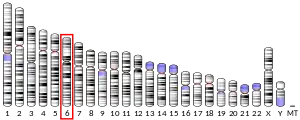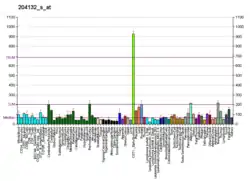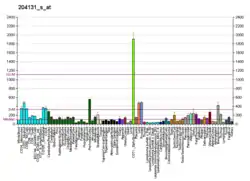FOXO3
Forkhead box O3, also known as FOXO3 or FOXO3a, is a human protein encoded by the FOXO3 gene.[5]
Function
FOXO3 belongs to the O subclass of the forkhead family of transcription factors which are characterized by a distinct fork head DNA-binding domain. There are three other FoxO family members in humans, FOXO1, FOXO4 and FOXO6. These transcription factors share the ability to be inhibited and translocated out of the nucleus on phosphorylation by proteins such as Akt/PKB in the PI3K signaling pathway (aside from FOXO6, which may be constitutively nuclear).[6] Other post-translational modifications including acetylation and methylation are seen and can result in increased or altered FOXO3a activity.
The use of FOXO3a knockout mice has revealed a diverse range of functions in both health and disease, namely infertility, lymphoproliferation, adenoma, organ inflammation, metabolism etc.; yet despite the purported importance of FOXO transcription factors in aging, FOXO3A knockout mice do not show an obvious shortening of lifespan or accelerated aging [7]
Apoptosis
Yu & Fellows et al. (2018) demonstrated that FOXO3a activation in vascular smooth muscle cells induces prominent apoptosis and extracellular matrix breakdown in vitro and exacerbates atherosclerosis and vascular remodelling in vivo. Also, these processes were at least partially dependent on MMP-13, as shown by siRNA knockdown and specific pharmacological inhibition. Further experiments also revealed MMP-13 as a novel, bona fide transcriptional target gene of FOXO3a in VSMCs.[8]
FOXO3a also functions as a trigger for apoptosis through upregulation of genes necessary for cell death, such as Bim and PUMA,[9] or downregulation of anti-apoptotic proteins such as FLIP.[10]
Stem cells
Gopinath et al.(2014)[11] demonstrate a functional requirement for FOXO3 as a regulator of Notch signaling pathway (an essential regulator of quiescence in adult stem cells) in the self-renewal of stem cells during muscle regeneration.
It is thought that FOXO3a is also involved in protection from oxidative stress by upregulating antioxidants such as catalase and MnSOD. Ron DePinho's group generated Foxo3 knockout mice, and showed that female exhibit a dramatic age-dependent infertility, due to premature ovarian failure.
Clinical significance
Deregulation of FOXO3a is involved in tumorigenesis,[12] for example translocation of this gene with the MLL gene is associated with secondary acute leukemia. Downregulation of FOXO3a activity is often seen in cancer (e.g. by increase in Akt activity resulting from loss of PTEN). FOXO3 is known as a tumour suppressor.
Alternatively spliced transcript variants encoding the same protein have been observed.[13]
The ketone body β-hydroxybutyrate has been shown in mice to increase gene expression of FOXO3a by histone deacetylase inhibition, upon which FOXO3a transcriptionally increased gene expression of the antioxidant enzymes SOD2 and catalase.[14] Plasma levels of β-hydroxybutyrate increase with fasting or a ketogenic diet.[15]
Association with longevity
Genetic variation in FOXO3 has been shown to be associated with healthspan and longevity in humans.[16] It is found in most centenarians across a variety of ethnic groups around the world.[17][18] The homologous genes daf-16 in the nematode C. elegans and dFOXO in the fruit fly are also associated with longevity in those organisms.. Mice lacking FOXO3 do not show obvious accelerated aging or shortened lifespan.
See also
References
- GRCh38: Ensembl release 89: ENSG00000118689 - Ensembl, May 2017
- GRCm38: Ensembl release 89: ENSMUSG00000048756 - Ensembl, May 2017
- "Human PubMed Reference:". National Center for Biotechnology Information, U.S. National Library of Medicine.
- "Mouse PubMed Reference:". National Center for Biotechnology Information, U.S. National Library of Medicine.
- Anderson MJ, Viars CS, Czekay S, Cavenee WK, Arden KC (Jan 1998). "Cloning and characterization of three human forkhead genes that comprise an FKHR-like gene subfamily". Genomics. 47 (2): 187–99. doi:10.1006/geno.1997.5122. PMID 9479491.
- Brunet A, Bonni A, Zigmond MJ, Lin MZ, Juo P, Hu LS, Anderson MJ, Arden KC, Blenis J, Greenberg ME (Mar 1999). "Akt promotes cell survival by phosphorylating and inhibiting a Forkhead transcription factor". Cell. 96 (6): 857–68. doi:10.1016/S0092-8674(00)80595-4. PMID 10102273. S2CID 14506473.
- Eijkelenboom A, Burgering BM (Feb 2013). "FOXOs: Signalling Integrators for Homeostasis Maintenance". Nature Reviews. Molecular Cell Biology. 14 (2): 83–97. doi:10.1038/nrm3507. PMID 23325358. S2CID 39922160.
- Yu H, Fellows A, Foote K, Yang Z, Figg N, Littlewood T, Bennett M (Mar 2018). "FOXO3a Links Vascular Smooth Muscle Cell Apoptosis, Matrix Breakdown, Atherosclerosis and Vascular Remodeling Through a Novel Pathway Involving MMP13". Arteriosclerosis, Thrombosis and Vascular Biology. 38 (3): 555–565. doi:10.1161/ATVBAHA.117.310502. PMC 5828387. PMID 29326312.
- Ekoff M, Kaufmann T, Engström M, Motoyama N, Villunger A, Jönsson JI, Strasser A, Nilsson G (Nov 2007). "The BH3-only protein Puma plays an essential role in cytokine deprivation induced apoptosis of mast cells". Blood. 110 (9): 3209–17. doi:10.1182/blood-2007-02-073957. PMC 2200922. PMID 17634411.
- Skurk C, Maatz H, Kim HS, Yang J, Abid MR, Aird WC, Walsh K (Jan 2004). "The Akt-regulated forkhead transcription factor FOXO3a controls endothelial cell viability through modulation of the caspase-8 inhibitor FLIP". The Journal of Biological Chemistry. 279 (2): 1513–25. doi:10.1074/jbc.M304736200. PMID 14551207.
- Gopinath SD, Webb AE, Brunet A, Rando TA (Apr 2014). "FOXO3 promotes quiescence in adult muscle stem cells during the process of self-renewal". Stem Cell Reports. 2 (4): 414–26. doi:10.1016/j.stemcr.2014.02.002. PMC 3986584. PMID 24749067.
- Myatt SS, Lam EW (Nov 2007). "The emerging roles of forkhead box (Fox) proteins in cancer". Nature Reviews Cancer. 7 (11): 847–59. doi:10.1038/nrc2223. PMID 17943136. S2CID 1330189.
- "Entrez Gene: FOXO3A forkhead box O3A".
- Shimazu T, Hirschey MD, Newman J, Verdin E (2013). "Suppression of oxidative stress by β-hydroxybutyrate, an endogenous histone deacetylase inhibitor". Science. 339 (6116): 211–214. doi:10.1126/science.1227166. PMC 3735349. PMID 23223453.
- Hartman AL, Gasior M, Vining EP, Rogawski MA (2007). "The neuropharmacology of the ketogenic diet". Pediatric Neurology. 36 (5): 281–292. doi:10.1016/j.pediatrneurol.2007.02.008. PMC 1940242. PMID 17509459.
- Timmers PR, Wilson JF, Joshi PK, Deelen J (July 2020). "Multivariate genomic scan implicates novel loci and haem metabolism in human ageing". Nature Communications. 11 (1): 3570. Bibcode:2020NatCo..11.3570T. doi:10.1038/s41467-020-17312-3. PMC 7366647. PMID 32678081.
- Willcox BJ, Donlon TA, He Q, Chen R, Grove JS, Yano K, Masaki KH, Willcox DC, Rodriguez B, Curb JD (Sep 2008). "FOXO3A genotype is strongly associated with human longevity". Proceedings of the National Academy of Sciences of the United States of America. 105 (37): 13987–92. Bibcode:2008PNAS..10513987W. doi:10.1073/pnas.0801030105. PMC 2544566. PMID 18765803.
- Flachsbart F, Caliebe A, Kleindorp R, Blanché H, von Eller-Eberstein H, Nikolaus S, Schreiber S, Nebel A (Feb 2009). "Association of FOXO3A variation with human longevity confirmed in German centenarians". Proceedings of the National Academy of Sciences of the United States of America. 106 (8): 2700–5. Bibcode:2009PNAS..106.2700F. doi:10.1073/pnas.0809594106. PMC 2650329. PMID 19196970.
Further reading
- Stahl M, Dijkers PF, Kops GJ, Lens SM, Coffer PJ, Burgering BM, Medema RH (May 2002). "The forkhead transcription factor FoxO regulates transcription of p27Kip1 and Bim in response to IL-2". Journal of Immunology. 168 (10): 5024–5031. doi:10.4049/jimmunol.168.10.5024. PMID 11994454.
- Morris BJ, Willcox DC, Donlon TA, Willcox BJ (Mar 2015). "FOXO3: A Major Gene for Human Longevity – A Mini-Review". Gerontology. 61 (6): 515–25. doi:10.1159/000375235. PMC 5403515. PMID 25832544.
- Kino T, Chrousos GP (Jun 2004). "Human immunodeficiency virus type-1 accessory protein Vpr: a causative agent of the AIDS-related insulin resistance/lipodystrophy syndrome?". Annals of the New York Academy of Sciences. 1024 (1): 153–67. Bibcode:2004NYASA1024..153K. doi:10.1196/annals.1321.013. PMID 15265780. S2CID 23655886.
- Hillion J, Le Coniat M, Jonveaux P, Berger R, Bernard OA (Nov 1997). "AF6q21, a novel partner of the MLL gene in t(6;11)(q21;q23), defines a forkhead transcriptional factor subfamily". Blood. 90 (9): 3714–9. doi:10.1182/blood.V90.9.3714. PMID 9345057.
- Anderson MJ, Viars CS, Czekay S, Cavenee WK, Arden KC (Jan 1998). "Cloning and characterization of three human forkhead genes that comprise an FKHR-like gene subfamily". Genomics. 47 (2): 187–99. doi:10.1006/geno.1997.5122. PMID 9479491.
- DaSilva L, Kirken RA, Taub DD, Evans GA, Duhé RJ, Bailey MA, Farrar WL (Oct 1998). "Molecular cloning of FKHRL1P2, a member of the developmentally regulated fork head domain transcription factor family". Gene. 221 (1): 135–42. doi:10.1016/S0378-1119(98)00441-7. PMID 9852958.
- Brunet A, Bonni A, Zigmond MJ, Lin MZ, Juo P, Hu LS, Anderson MJ, Arden KC, Blenis J, Greenberg ME (Mar 1999). "Akt promotes cell survival by phosphorylating and inhibiting a Forkhead transcription factor". Cell. 96 (6): 857–68. doi:10.1016/S0092-8674(00)80595-4. PMID 10102273. S2CID 14506473.
- Medema RH, Kops GJ, Bos JL, Burgering BM (Apr 2000). "AFX-like Forkhead transcription factors mediate cell-cycle regulation by Ras and PKB through p27kip1". Nature. 404 (6779): 782–7. Bibcode:2000Natur.404..782M. doi:10.1038/35008115. PMID 10783894. S2CID 205005804.
- Brunet A, Park J, Tran H, Hu LS, Hemmings BA, Greenberg ME (Feb 2001). "Protein kinase SGK mediates survival signals by phosphorylating the forkhead transcription factor FKHRL1 (FOXO3a)". Molecular and Cellular Biology. 21 (3): 952–65. doi:10.1128/MCB.21.3.952-965.2001. PMC 86685. PMID 11154281.
- Schuur ER, Loktev AV, Sharma M, Sun Z, Roth RA, Weigel RJ (Sep 2001). "Ligand-dependent interaction of estrogen receptor-alpha with members of the forkhead transcription factor family". The Journal of Biological Chemistry. 276 (36): 33554–60. doi:10.1074/jbc.M105555200. PMID 11435445.
- Kops GJ, Medema RH, Glassford J, Essers MA, Dijkers PF, Coffer PJ, Lam EW, Burgering BM (Apr 2002). "Control of cell cycle exit and entry by protein kinase B-regulated forkhead transcription factors". Molecular and Cellular Biology. 22 (7): 2025–36. doi:10.1128/MCB.22.7.2025-2036.2002. PMC 133681. PMID 11884591.
- Mahmud DL, G-Amlak M, Deb DK, Platanias LC, Uddin S, Wickrema A (Feb 2002). "Phosphorylation of forkhead transcription factors by erythropoietin and stem cell factor prevents acetylation and their interaction with coactivator p300 in erythroid progenitor cells". Oncogene. 21 (10): 1556–62. doi:10.1038/sj.onc.1205230. PMID 11896584.
- Nadal A, Marrero PF, Haro D (Aug 2002). "Down-regulation of the mitochondrial 3-hydroxy-3-methylglutaryl-CoA synthase gene by insulin: the role of the forkhead transcription factor FKHRL1". The Biochemical Journal. 366 (Pt 1): 289–97. doi:10.1042/BJ20020598. PMC 1222772. PMID 12027802.
- Wistow G, Bernstein SL, Wyatt MK, Fariss RN, Behal A, Touchman JW, Bouffard G, Smith D, Peterson K (Jun 2002). "Expressed sequence tag analysis of human RPE/choroid for the NEIBank Project: over 6000 non-redundant transcripts, novel genes and splice variants". Molecular Vision. 8: 205–20. PMID 12107410.
- Modur V, Nagarajan R, Evers BM, Milbrandt J (Dec 2002). "FOXO proteins regulate tumor necrosis factor-related apoptosis inducing ligand expression. Implications for PTEN mutation in prostate cancer". The Journal of Biological Chemistry. 277 (49): 47928–37. doi:10.1074/jbc.M207509200. PMID 12351634.
- Charvet C, Alberti I, Luciano F, Jacquel A, Bernard A, Auberger P, Deckert M (Jul 2003). "Proteolytic regulation of Forkhead transcription factor FOXO3a by caspase-3-like proteases". Oncogene. 22 (29): 4557–68. doi:10.1038/sj.onc.1206778. PMID 12881712.
- Crossley LJ (Oct 2003). "Neutrophil activation by fMLP regulates FOXO (forkhead) transcription factors by multiple pathways, one of which includes the binding of FOXO to the survival factor Mcl-1". Journal of Leukocyte Biology. 74 (4): 583–92. doi:10.1189/jlb.0103020. PMID 12960271. S2CID 15199594.
- Sunters A, Fernández de Mattos S, Stahl M, Brosens JJ, Zoumpoulidou G, Saunders CA, Coffer PJ, Medema RH, Coombes RC, Lam EW (Dec 2003). "FoxO3a transcriptional regulation of Bim controls apoptosis in paclitaxel-treated breast cancer cell lines". The Journal of Biological Chemistry. 278 (50): 49795–805. doi:10.1074/jbc.M309523200. PMID 14527951.
- Yu H, Fellows A, Foote K, Yang Z, Figg N, Littlewood T, Bennett M (Mar 2018). "FOXO3a Links Vascular Smooth Muscle Cell Apoptosis, Matrix Breakdown, Atherosclerosis and Vascular Remodeling Through a Novel Pathway Involving MMP13". Arteriosclerosis, Thrombosis and Vascular Biology. 38 (3): 555–565. doi:10.1161/ATVBAHA.117.310502. PMC 5828387. PMID 29326312.
- Skurk C, Maatz H, Kim HS, Yang J, Abid MR, Aird WC, Walsh K (Jan 2004). "The Akt-regulated forkhead transcription factor FOXO3a controls endothelial cell viability through modulation of the caspase-8 inhibitor FLIP". The Journal of Biological Chemistry. 279 (2): 1513–25. doi:10.1074/jbc.M304736200. PMID 14551207.
- Dansen TB, Kops GJ, Denis S, Jelluma N, Wanders RJ, Bos JL, Burgering BM, Wirtz KW (Jan 2004). "Regulation of sterol carrier protein gene expression by the forkhead transcription factor FOXO3a". Journal of Lipid Research. 45 (1): 81–8. doi:10.1194/jlr.M300111-JLR200. PMID 14563822.;chih长此人十二厂二
External links
- FOXO3A+protein,+human at the US National Library of Medicine Medical Subject Headings (MeSH)
This article incorporates text from the United States National Library of Medicine, which is in the public domain.







